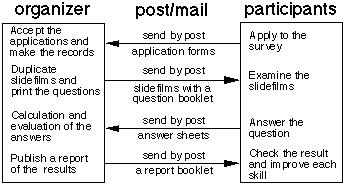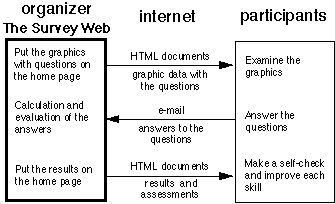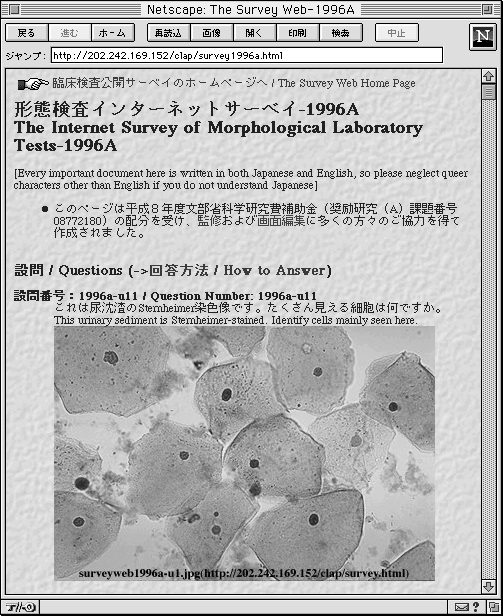Abstract
Control surveys of morphological laboratory tests using slidefilms consume a lot of money and man power, so only a small part of clinical laboratories and no individual can have participated in them. The internet and its world wide web system was adopted to give such possible participants easy access to those surveys.
16 digitized photographs of laboratory tests with questions were put on a home page named 'the Survey Web' (http://202.242.169.152/clap/survey.html). Anyone who has access to this home page could be a regular participant by sending answers via e-mail. Later, the summarized results and model answers were published at the same home page for the participants to review by themselves.
All of four specialists judged that the quality of each photograph on the computer monitors fills the minimum requirements for the survey. During two months, 889 times of access to the Survey Web were made, and six voluntary answers were received. No problem on distributing graphics data was detected except that one case of trouble in displaying one of 16 pictures was reported.
In conclusion, the WWW system can be successfully used in morphological control surveys and brings many advantages that slidefilms lack.
Keywords
Internet; World Wide Web; Control Survey; Laboratory Test; Standardization
Introduction
The standardization of laboratory tests is one of the most important and urgent subjects in the area of laboratory medicine and clinical pathology, not only in analytical tests but also in morphological tests. Control surveys using slidefilms have been the only way for the external quality control of morphological laboratory tests. Figure 1 shows typical procedure of conventional surveys using slidefilms. Preparation and distribution of a lot of slidefilms and attached documents need costly processes. When the number of applicants increases, the cost expands larger.

Slidefilms used in morphological control surveys have some limitations.
- So costly that individuals or small laboratories hesitate to join in the survey.
- The number of pictures for examination distributed at a time is limited.
- It is not so easy to make every picture on duplicated slidefilms identical.
As a breakthrough of these limitations, the internet and its world wide web system was adopted.
Materials and Methods
Figure 2 shows the procedure of a survey conducted by us using the internet. 16 photographs of laboratory tests were digitized using Kodak Photo CD(TM) system and processed using Adobe Photoshop(TM) software. To reduce the network load during distribution, each graphic data was compressed using JPEG format to make its size as small as possible unless it loses the minimum requirements of its graphical quality. Each graphic data was checked its quality using various CRT monitors and flat panel displays. After compression, there were large difference in data size among them, smallest one was 20k bytes and largest one was 144k bytes, though all of them have the same graphical size, 372 x 254 pixel in 72 dpi.

After that, these digitized photographs were put on a home page, named 'the Survey Web' (http://202.242.169.152/ clap/survey.html), with corresponding questions. Anyone who has access to this home page could be a regular participant. Answers were received via e-mails only, and in few weeks after the deadline, the summarized results, model answers and the assessments commented by specialists were appeared at the same home page for the participants to check their answers by themselves.
When you make access to the Survey Web, you will see a list of the question pages of all surveys and the report pages of finished surveys. You can go to each page by clicking its item name as you like.
Figure 3 shows the top portion of a question page. In this home page, every important document is written in both Japanese and English. If you would like to join the survey, click 'How to Answer' and follow the instruction displayed. This picture you see here is the first microphotograph of urinary examination. To see other pictures and questions, simply scroll this page downwards.

At present, the survey categories are urinary examination, hematology and microbiology, and in the near future, clinical immunology, cytology and clinical physiology will be included.
Results
After some revisions, the graphical quality of every 16 pictures which were distributed through the internet and displayed on computer monitors came to pass the judgment of four specialists of concerned fields. After announcement at some internet newsgroups, 889 times of access to the Survey Web were made during two months, and six voluntary answers were received from three clinical laboratories and three laboratory technicians in Japan. Further, three contacts were made from U.S., Russia and South Africa.
Time consumed to send all 16 pictures (664,930bytes of graphic data) through the internet varied from 2 minutes to 20 minutes. One participant reported that one of 16 graphics was not displayed properly at her site, but the cause was not clear. Otherwise, no evidence of major problems on distributing graphic data was detected.
After the survey finished, there have been constant access to the Survey Web (about 60 times a month on average), which is possibly for the educational purposes.
Discussion
This experiment demonstrated great advantage of the internet used in morphological control surveys.
- Individuals and small laboratories can easily join in the survey.
- The number of distributed pictures has no limit.
- Exactly same digitized graphics can be distributed.
- International surveys will be conducted without increase of the cost.
- The home page used for the survey is also useful as an electronic textbook for public use.
But we should recognize that the graphical quality of various abnormal specimens and the graphical differences among many types of computer displays are left to be examined.
Conclusion
The WWW system is considered to be successfully used in
morphological control surveys and it brings not only great reduction of a cost of distribution of pictures and documents but also many other advantages, so further investigation and more experience should be encouraged. This project will effectively promote the standardization in skills of morphological identification not only in Japan but also all over the world , so co-promoters in various countries are welcome.
Acknowledgments
We are grateful to the Japanese Association of Clinical Laboratory Physicians for their great support to this project.
This work was supported by a Grant-in-Aid from the Ministry of Science, Education and Culture of Japan (Grant No.08772180).
Address for correspondence
Masahiro Nishibori
Clinical Laboratory, Tokyo Medical and Dental University Medical Hospital
1-5-45, Yushima, Bunkyo-ku, Tokyo 113, Japan
E-mail: mn.mlab@tmd.ac.jp